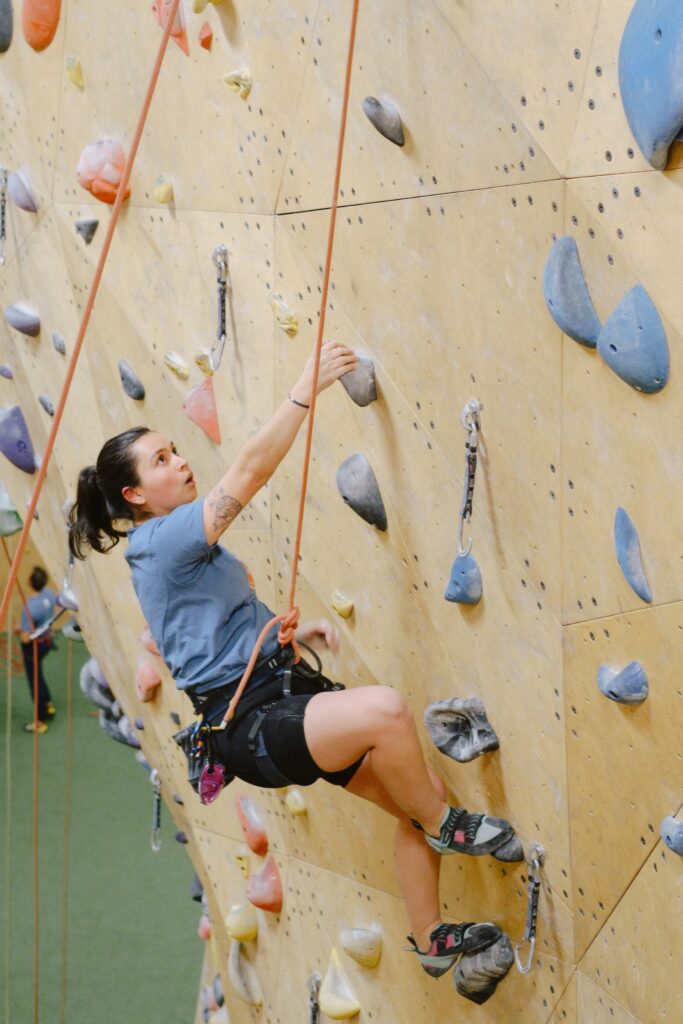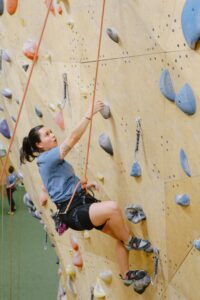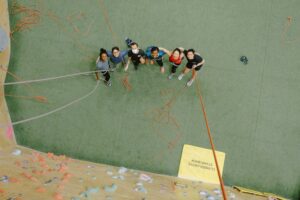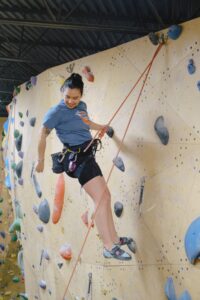

Written by: Jessica Kasiama, Writer in Residence, Colour the Trails
Photos by: Allison Seto
According to the Chicago Tribune, the term runner’s high first surfaced in the 1970s during the popularization of recreational running in the United States. Runner’s high is defined as a fleeting state of euphoria that one reaches after intense and prolonged exercise. When we engage in physical activity, we are oftentimes looking for something specific: a result, a feeling, a spark of inspiration, a sense of belonging or a shift in perspective. Whatever it is, the feeling we are looking for goes beyond the surface, beyond Instagram: it runs deep. That high, that sensation, can allow for a momentary sense of reprieve from the busyness of everyday life.
Alberta-based climbing instructor Coralia Sevilla described something similar, having found peace in the presence that rock climbing, as a sport, calls for.
“When you’re on [the climbing wall], looking down, that’s all you have to think about.” The feeling translates beyond the walls of the rock climbing gym as Sevilla recalls climbing in the outdoors and navigating the crags. It is a feeling of minatureness, a feeling of smallness that puts things into perspective. “Mountains, and the outdoors, have that power. When you’re standing there and you look so little, you just realize: wow, I’m just a piece of this bigger puzzle, and I can afford to just be here right now, and enjoy the environment that I’m in. Ultimately, I’m not as competitive as some other people that participate in the sport. Because for me, it’s not about the competition, or climbing hard or doing certain things with a certain difficulty. This is where I can let myself just be and be present. And if I can share that with other people, that’s great.”
And Sevilla was able to do exactly that by sharing her passion for climbing with the Color the Trails community. Last November, we invited Coralia to help instruct an Introduction to Indoor Climbing course as a way to introduce participants to the basic skills required to top-rope climb and belay. Late December, I met up with Coralia via Zoom to reminisce about her experience with Color the Trails, talk about the barriers that exist in this space, de-centering competition, prioritizing mental health and the beauty of community.

From an outside perspective, rock climbing may seem like the kind of sport that places emphasis on the individual. However, community and collaboration are the lifeblood of this sport. Early in her rock climbing journey, Coralia was surprised to observe how oftentimes, collaboration in the rock climbing world was often misinterpreted as romantic interest. Perhaps, this speaks to a greater flaw in how we define community as a collective and how romantic affection is often centered as our primary way of relating to one another. The truth is that from a chosen family to a network of neighbors, all forms of community matter. Community can be vital to your rock-climbing journey. Finding a group, or a person, that you click with allows for a trusting relationship that can help minimize the risks of outdoor climbing. It can also help cultivate a sense of harmony and togetherness. Although it can be difficult to find your network, the reward is worthwhile. Coralia offers this reassurance: “Once you find people within the community, they can feel like family.”
Rock climbing also allows individuals to strengthen the relationship that one has with themselves. Coralia advises climbers to define and honor their own boundaries in order to enjoy the sport: “In the gym, I have to check in with myself on how I’m feeling because it will dictate how I climb. For example, if I know that I had a bad day and didn’t necessarily rest well, I’ll choose easier climbs for myself that day because the sport demands so much of you. You have to take it easy on yourself.”
Mental state is a key factor in climbing successfully and safely. Although Sevilla has found a community of people who align with this position, she has observed how unspoken hierarchies can seep into the climbing gym when competition is centered and used as a way to measure someone’s level of commitment or passion:
“I don’t think your achievement in the sport in terms of physical capacity dictates your dedication to it. I’m a school teacher, and I’m sacrificing my weekend holiday to be [at the gym] and show up for the community. Taking time out of my rest to share this experience with other people. Does that not make me dedicated to this sport, or to this gym or company? Just as much as you would? Yeah, you may have the free time to climb harder, climb more and escalate your skills, but I’m pretty confident and solid in my skills. I just choose to affect the community in a different way. I’d rather share the sport with more people. Yes, I get gratification from climbing harder and doing better, but it’s not the same. It’s not the way I am as a person.”

A strong community honors your boundaries. This is one of the great gifts of the sport. However, it is important to note that it is not easy to access the gifts of climbing or, more broadly, the outdoors. The social and financial barriers are enough to prevent someone from even considering outdoor activity as a possibility. Coralia is adamant in pointing out the misconception of rock-climbing as an accessible sport. Yes, there is a ruggedness to it that makes it feel open to people from all walks of life but it is also something that is mainly accessible to those who have the financial means to access the equipment as well as carve out the time and space to pursue the sport.
“The main reason why I don’t see people around me doing this is because it’s hard to do. And the only reason why I was able to afford to do what I’ve done so far is because I worked at Lululemon. They finance you being able to go to studios and do things. I didn’t have to pay $23.10 to climb for one day. That’s another $5 for rental shoes and another $5 for a harness rental. Or you could buy the gear, which is $100, for shoes, $100 for harness, and $30 for a belay device. That’s a huge entry fee into something that seems so simple. And then when your shoes wear down, you have to get another pair. I’ve had to find my space in the world and my voice in life In order for me to even get to the point of being able to prioritize myself. Just because it’s outdoorsy doesn’t mean it’s any cheaper or more accessible. To get out to the mountains, you have to have a car, driver’s license, and money for gas. The outdoors are not readily accessible to everyone and that’s why you don’t see us out there as much.”
Recognizing the barriers are the first step in breaking through and there are many examples of community gathering in order to do so. Sevilla shouts out a gym called Memphis Rox, a Black-owned gym that operates as a non-profit. Memphis Rox has a pay-what-you-can program, focusing on helping people with limited outdoors experiences in accessing gym time, fear, and memberships. Spaces like this are vital to the work of making space for those who are underrepresented.
With accessibility comes the question of meaningful representation. This is a large part of the ethos of Color the Trails; an aspect that helped shape our collaboration with the passionate instructor. Our climb night with Sevilla gave new climbers the opportunity to gather in a safer space.
“[The participants] were passionate about being there. I remember I made a reference to Dora the Explorer to explain some of the techniques and everybody laughed and they were totally on board. They’re like: yeah, of course, Dora, who else would be like climbing up there with ropes. [We had] that inner connection that you can just feel. I got all misty eyed and probably caused a couple other people to cry. It is a lot of work to fight for ourselves, for sure, a lot of mental energy but [climb night emphasized the] feeling that we can empower ourselves.”

It is clear that Coralia’s background in sports and as a teacher, and working with young students, seeps into her holistic approach to climbing and instruction. She values advocacy, empathy and transparency. All of this lends itself to the notion that this sport is not about climbing hard, it is about climbing as you are in order to access a sense of peace, mindfulness and balance within oneself. Whether you are interested in scaling gym walls or mountains, there is something to learn from Sevilla’s holistic approach to the outdoors and outdoor activity. De-center the destination. Focus on the present moment. Honor your boundaries. And go where there is community. On the other side of fear, you may find a feeling of interconnectedness. You might find that ineffable feeling of peace, even just for a brief moment. On the other side, you might find yourself.
Interested in trying a new event or activity and hanging out with the CTT BIPOC community? Check out our upcoming events at colourthetrails.com/events and join the community on Instagram, Facebook (BC Chapter, AB Chapter, ON Chapter) and YouTube
